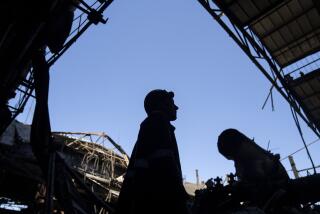Russian Nuclear Facilities Called Perilous : Safety: American experts say the industry is so dangerously antiquated that more accidents are virtually inevitable.
- Share via
WASHINGTON — Despite five years of intermittent Western-backed safety programs, Russia’s sprawling nuclear industry remains so dangerously antiquated that more accidents like this week’s explosion of a radioactive waste tank are virtually inevitable, U.S. experts said Wednesday.
In the short run, environmental experts said, the only way to deal with plants like the Tomsk-7 plutonium reprocessing facility, where Tuesday’s accident occurred, is to shut them down.
“This incident was at a plant that shouldn’t have been operating to begin with,” said Tom Cochran, senior scientist at the Natural Resources Defense Council.
The facility, near the Siberian city of Tomsk, was designed to produce plutonium for the Soviet Union’s nuclear weapons. It is one of three still operating. The others are at Krasnoyarsk in Siberia and Chelyabinsk in the Urals.
Now that Russia has agreed to dismantle much of its nuclear arsenal, there is no reason to produce additional plutonium, Cochran said.
However, Russia has resisted calls for dismantling the plants. U.S. officials said that Russian President Boris N. Yeltsin’s government seems reluctant to shut the facilities because that would eliminate badly needed jobs. In addition, officials said, Russian industrialists believe that they can make money by selling plutonium on the international energy fuel market, although U.S. economists said that they believe the value of the material is far below its cost of production.
Even if Moscow agrees to close the plutonium processing plants, most of the nuclear industry will remain because there is no way that the hard-pressed Russian economy could afford to shut down the nuclear power stations that provide about 12% of the nation’s electricity supply. And dependence on nuclear power is even greater in some other republics of the former Soviet Union, such as Ukraine, where 24% of the power is from nuclear sources, and Lithuania, where the figure is 58%.
Five years ago, the United States and the Soviet Union agreed to begin a joint effort to improve the safety of nuclear plants through better management techniques, training and operating procedures. But most of the effort, so far, has been limited to exchanges of information. The political turmoil that marked the breakup of the Soviet Union into 15 independent republics has slowed the program.
A Nuclear Regulatory Commission official said the United States has spent about $25 million so far on construction of plant simulators for training in Russia and Ukraine, development of a manual of safety procedures and other projects.
“I can’t say there has been major improvement at the plant level,” the official said. “It is a longtime effort to try to improve the safety culture at the plants and create a new interest in safety in the operation of the facilities. It is an enormous problem to try to change a direction that was set many years ago.”
During his Vancouver summit meeting with Yeltsin last weekend, President Clinton pledged $15 million to pay for short-term operational safety improvements, risk reduction measures and regulatory assistance for ex-Soviet nuclear power plants. The President also offered $10 million to help Russia store and safeguard nuclear fuel.
The NRC official said that the money was in addition to the $25 million promised earlier.
Cochran said that the Tomsk plant had long been a source of environmental pollution even before the accident.
“We think that for economic, environmental and arms control reasons they shouldn’t be operating these chemical separation plants,” he said.
More to Read
Sign up for Essential California
The most important California stories and recommendations in your inbox every morning.
You may occasionally receive promotional content from the Los Angeles Times.













